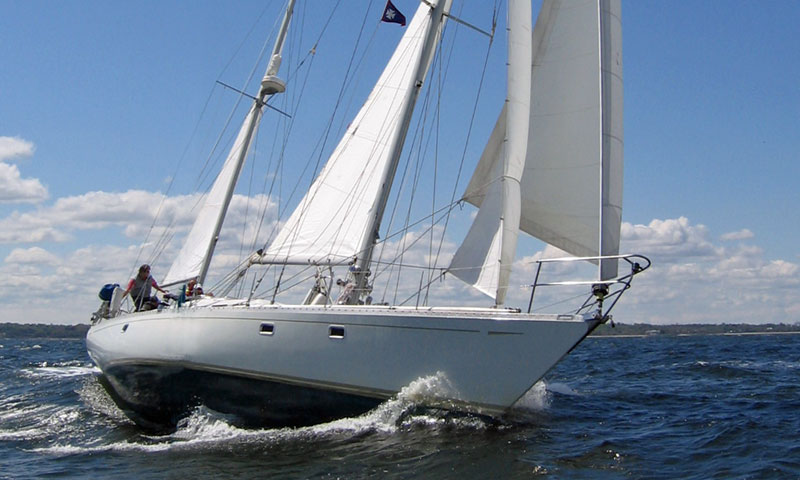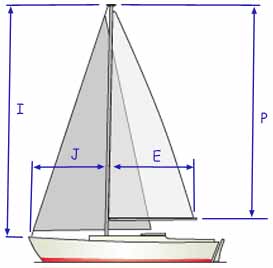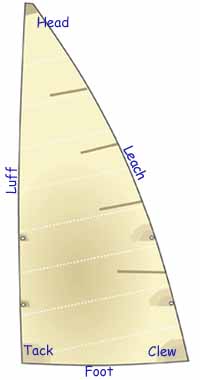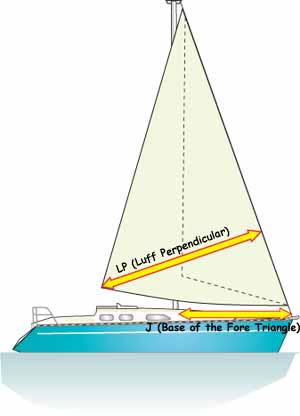What Sail Dimensions are Required to Calculate Sail Areas?
The required sail dimensions for calculating the area of any triangular sails are usually its height and the length of its foot. But that only works for mainsails and mizzens with no roach, and jibs with a 90 degree angle at the clew - and what about high-cut headsails, spinakers and cruising chutes? Read on...
 A 57' staysail ketch flying all four sails to great effect...
A 57' staysail ketch flying all four sails to great effect...Incidentally, the cloth from which a sail is made contributes significantly to the performance of the sail. Materials like Dacron are known for their durability and affordability, while more advanced materials like Spectra offer superior strength-to-weight ratios. The choice of sailcloth depends on the intended use of the sail and the budget of the sailor.
Foresail and mainsail dimensions are universally referenced with the letters 'J', 'I', 'E' and 'P' approximating to the length of the foredeck, height of the mast, length of the boom and the height of the main sail - but more accurately defined further down this page.
Yacht designers need these sail dimensions to calculate thought provoking stuff such as the sail-area/displacement ratios of their creations, and sailmakers need them before they put scissors to sailcloth.
If our sailboat's sails were perfectly triangular then, as every schoolboy knows, their area would be 'half the height, times the base' - but with the possible exception of a mainsail with a straight luff, generally they're not. Here's how it works...
Main and Mizzen Sail Dimensions
These are almost right-angled triangles except for the curvature of the leach (the 'roach') which increases the sail area.
 Primary dimensions for calculating areas of triangular sails
Primary dimensions for calculating areas of triangular sailsIt's usually calculated as:
Area = (luff x foot)/1.8, or
Area = (P x E)/1.8, where:
- 'P' is the distance along the aft face of the mast from the top of the boom to the highest point that the mainsail can be hoisted, and
- 'E' is the distance along the boom from the aft face of the mast to the outermost point on the boom to which the main can be pulled.
For the mizzen sails on ketches and yawls, 'P' and 'E' relate to the mizzen mast and boom.
For more heavily roached sails, the increased area can be accounted for by reducing the denominator in the formula to 1.6.
Clearly calculating sail areas isn't going to be an exact science...
Jibs, Genoas and Staysail Dimensions
 Names given to edges and corners of a triangular sail
Names given to edges and corners of a triangular sailFor a working jib that fills the fore triangle - but no more - and with a foot that's parallel to the deck, then you've got a 'proper' right-angled triangular sail, whose area is:~
Area = (luff x foot)/2, or
Area = (I x J)/2, where:
- 'I' is the distance down the front of mast from the genoa halyard to the level of the main deck, and
- 'J' is the distance along the deck from the headstay pin to the front of the mast.
Genoas, by definition, have a clew which extends past the mast and are described by the amount by which they do so. For instance a 135% genoa has a foot 35% longer than 'J' and a 155% genoa 55% longer. Areas are calculated as follows:~
Area (135% genoa) = (1.44 x I x J)/2, and
Area (155% genoa) = (1.65 x I x J)/2
High-cut Headsails
 The same formula applies, but the base is the luff length and the height is the luff perpendicular
The same formula applies, but the base is the luff length and the height is the luff perpendicularBut these formulae don't work for a high-cut jib with a raised clew - unless you imagine the sail turned on its side such that the luff is the base and the luff perpendicular is the height.
It's still a simple calculation though, once you know the length of the luff perpendicular (LP), the sail area is:
Area = (luff x luff perpendicular)/2, or
Area = (L x LP)/2, where:
- 'L' is the distance along the forestay from the headstay pin to the front of the mast, and
- 'LP' is the shortest distance between the clew and the luff of the genoa.
Spinnaker Sail Dimensions
Much like calculating foresail areas, but with different multipliers for conventional spinnakers and asymmetric spinnakers...
Conventional Spinnakers
Area = (0.9 x luff x foot), or
Area = (0.9 x I x J), where:
- 'I' is the distance from the highest spinnaker halyard to the deck, and
- 'J' is the length of the spinnaker pole.
Asymmetric Spinnakers
Area = (0.8 x luff x foot), or
Area = (0.8 x I x J), where:
- 'I' is the distance from the highest spinnaker halyard to the deck, and
- 'J' is the distance from the front face of the mast to the attachment block for the tackline.
For those well-versed in sailing and familiar with sail geometry, understanding the precise influence of I, P, J and E measurements on sail area calculations is essential for optimizing performance. These dimensions not only define the sail plan but also impact balance, handling, and overall efficiency under various sailing conditions.
But, the question that remains unanswered is, "how does a yacht designer decide on the sail measurements I, P, J and E in the first place?"
Recent Articles
-
Wheel-Steering Autopilots: Your Questions Answered...
Apr 18, 25 03:45 PM
Whatever your question, you should find the answer here -
Tiller Pilots: Your Questions Answered...
Apr 18, 25 08:18 AM
Got a question about sailboat tiller pilots? Odds are, you'll find the answer here -
Is Marine SSB Still Used?
Apr 15, 25 02:05 PM
You'll find the answer to this and other marine SSB-related questions right here...












